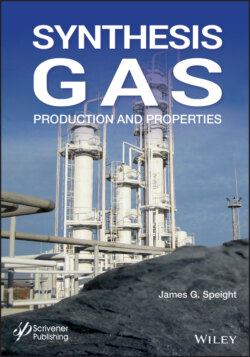Читать книгу Synthesis Gas - James Speight G., James G. Speight - Страница 32
2.3.1 Natural Gas
ОглавлениеSynthesis gas can be produced from natural gas, or virtually any hydrocarbon feedstock, by reaction of the feedstock with steam or oxygen. The reaction of the hydrocarbon with oxygen can be represented by the simple equations:
The formation of synthesis gas is strongly endothermic and requires high temperatures. Steam reforming of natural gas (or shale gas) proceeds in tubular reactors that are heated externally. The process uses nickel catalyst on a special support that is resistant against the harsh process conditions. Waste heat from the oven section is used to preheat gases and to produce steam. This plant generates synthesis gas with hydrgoen-carbon monoxide (H2/ CO) ratios in the range of 3 to 4, and is suitable for hydrogen production.
The partial oxidation of methane (or other hydrocarbon derivatives) is a non-catalytic, large-scale process to make synthesis gas and yields synthesis gas with a hydrogen-carbon monoxide (H2/CO) ratio on the order of 2. This is an optimal ratio for gas-to-liquids plants. A catalytic version of partial oxidation that is based on short-contact time conversion of methane, hydrocarbon derivatives or biomass on, for example, rhodium catalysts, is suitable for small-scale applications (Zhu et al., 2004; De Campos Roseno et al., 2018).
